
- [ August 24, 2024 ] Opus Dei prelate responds to those who consider group ‘conservative, powerful and secretive’ News Briefs
- [ August 24, 2024 ] U.S. Catholics fund replacement for cathedral bell destroyed in atomic bombing of Nagasaki News Briefs
- [ August 24, 2024 ] New film ‘Reagan’ aims to unite, says Catholic actor News Briefs
- [ August 23, 2024 ] Chicago pregnancy center vandalized as Democratic National Convention closes News Briefs
- [ August 23, 2024 ] Robert F. Kennedy Jr. suspends campaign, urges voters to elect Donald Trump News Briefs


Ten great works about the life and thought of Pope St. John Paul II
Books by George Weigel, Andrea Riccardi, Sławomir Oder, Darcy O’Brien, and others, along with one film.
May 12, 2020 Filip Mazurczak The Dispatch 1 Print
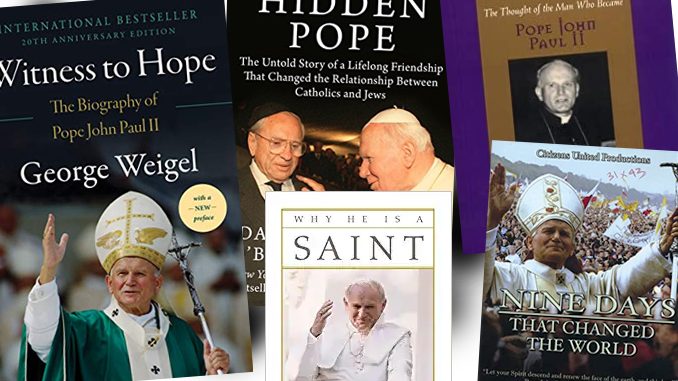
The hundredth anniversary of the birth of St. John Paul II, one of the most influential popes in Church history, will be on Monday May 18. Because of COVID-19 lockdown measures, some of us have more opportunities to read books and watch movies than usual. What better time to learn more about Karol Wojtyła’s life, thought, and legacy than now? Here is a list of the ten exceptional works about Pope St. John Paul II: nine books and one film.
• Witness to Hope (Harper Perennial, 2001) ; The End and the Beginning: Pope John Paul II – The Victory of Freedom, the Last Years (Image, 2010), the Legacy; Lessons in Hope: My Unexpected Life with St. John Paul II (Basic Books, 2017), by George Weigel
If you ever read about Pope John Paul II in works of history and look at the footnotes, they will likely reference Weigel’s books, especially Witness to Hope , the definitive biography of the pontiff. George Weigel spent years interviewing the pope and people who knew him in Poland, Rome, and elsewhere. Witness to Hope works well as an encyclopedia on John Paul’s life and especially his pilgrimages to different nations and their social, political, and religious context and impact.
Many of Weigel’s interlocutors have revealed rather interesting details and shared quotable remarks. For example, Cardinal Jaime Sin, the late archbishop of Manila and the informal leader of the 1986 peaceful revolution against the dictatorship of Ferdinand Marcos in the Philippines, tells Weigel that he was inspired by the examples of John Paul II and Solidarity. Meanwhile, Weigel quotes Archbishop Vincenzo Paglia, the postulator of the cause for canonization of St. Oscar Romero, who was unfairly and inaccurately accused by some of being a Marxist sympathizer, who says of the Salvadoran martyr: “This bishop is the Church’s bishop, not the Left’s bishop.”
Witness to Hope was published in early 2000, five years before John Paul II’s death. The End and the Beginning , however, is not a mere sequel. Apart from chronicling the last five years of the saint’s life (including his death, which moved millions), it also features a fine assessment of John Paul II’s role in the collapse of communism.
The most recent part of the “Weigel trilogy” is Lessons in Hope . This is Weigel’s engaging and never self-indulgent memoir of how he wrote Witness to Hope . The book contains a myriad of many great names in Catholic history Weigel had the privilege of meeting while working on the book. Chronicling Weigel’s beginnings as a journalist in the 1970s and his evolution as one of America’s leading Catholic commentators, Lessons in Hope can also be inspiring reading for aspiring young writers.
• City of Saints: A Pilgrimage to John Paul II’s Krakow (Image, 2015), by George Weigel, Carrie Gress, Stephen Weigel
Weigel also co-authored a fine book on Krakow, the city where Karol Wojtyła lived from 1938 until his election to the papacy forty years later. When the pandemic ends and international travel again becomes possible, John Paul II’s Krakow is a great place to visit, and the Weigels and Carrie Gress provides an excellent historical introduction to the place where his vocation matured. We learn about the city’s medieval history and its more recent oppression under Nazi Germany and communist rule.
Weigel introduces the reader to such Krakow saints as Stanislaus, Bishop and Martyr; Jadwiga, Queen of Poland; or Albert Chmielowski. We learn about places closely linked to Wojtyła, such as Nowa Huta, the working class neighborhood centrally planned by communists, who unsuccessfully tried to create a district without God, or the quarry where he worked under German occupation, which helped him to develop his teaching on the value of human labor. Trust me; this is a much better guide to Krakow than anything from Lonely Planet or Fodor’s.
• John Paul II: The Biography (Cinisello Balsamo 2011), by Andrea Riccardi
Apart from George Weigel’s trilogy, the best biography of John Paul II I’ve read is by Andrea Riccardi, originally written in Italian, but translated into numerous European languages, including Spanish, Portuguese, Polish, and French. Unfortunately, English is not one of them. I hope that including this book in this article could interest some publisher in an English translation.
Andrea Riccardi is the founder of the Community of Sant’Egidio, a lay Catholic community from Italy that is present throughout the world and is devoted to promoting peace (the community played a key role in the negotiations ended the civil war in Mozambique) and aiding the poor and refugees. He is also a professor of history and a sometime politician.
Apart from standard information about Karol Wojtyła’s youth and formation found in all other biographies, this book contains many prescient analyses of the political impact of many of St. John Paul II’s teachings, actions, and pilgrimages. Many are much less known than the familiar narrative of the 1979 visit to Poland and its role in inspiring the foundation of Solidarity, including John Paul II’s clashing with the Bush administration over the invasion of Iraq, his attitude to the ethnic cleansing in the Balkans in the 1990s, his attempts at mediation in the Arab-Israeli conflict, and many other fascinating stories.
One chapter is brilliantly titled “No to Communism, Not Yes to Capitalism.” In it, Riccardi deconstructs the media caricature of John Paul II as basically the Henry Kissinger of the Vatican. Yes, Riccardi writes, John Paul II knew the philosophical foundations of Marxism-Leninism and himself experienced communist rule firsthand, so he was not naïve about the anthropological lies of communism. However, he had no taste for laissez-faire capitalism, with its greedy materialism and marginalization of the poor, either.
• Why He Is a Saint: The Life and Faith of Pope John Paul II and the Case for Canonization (Rizzoli, 2010), by Sławomir Oder
With the possible exception of George Weigel, arguably no one knows more about John Paul II than Father Sławomir Oder, a Polish priest who served as the postulator for the pope’s cause for canonization. Father Oder spent hundreds of hours speaking to people who knew John Paul II and went through thousands of pages of documents related to his life.
In Why He Is a Saint , Oder shares all he learned about John Paul with his readers. The book also reveals much fascinating information for the first time, such as that during his meeting with Augusto Pinochet behind closed doors Pope St. John Paul II asked him to give democracy a chance. This inspired the Chilean dictator, who considered himself a Catholic, to hold a plebiscite on bringing back civilian rule to his country.
• The Hidden Pope: The Untold Story of a Lifelong Friendship That Changed the Relationship Between Catholics and Jews (Rodale Books, 1998), by Darcy O’Brien
Over the past two millennia, relations between Jews and Christians have often been tense and painful. Although there have been plenty of Catholic friends of the Jews in history, such as St. Augustine or Pope Gregory IX, the tragic truth is that there have been many examples of Christian persecution of Jews across the centuries.
Pope St. John Paul II, however, reminded the world that the Jews are the Christians’ elder brothers in the faith. He repeatedly condemned anti-Semitism, and he became the first pope to make an official visit to a synagogue and to establish diplomatic relations between the Holy See and Israel.
Darcy O’Brien’s beautiful book tells the story of the lifelong friendship between Karol Wojtyła and Jerzy Kluger, which started in their hometown of Wadowice, Poland, when they were childhood pals. Karol’s visits to Jerzy’s house, including for Seder meals and the lighting of Shabbos candles, were his first direct exposure to Judaism.
During World War II, Kluger took part in the Polish II Corps, an Allied army of Polish gulag prisoners freed by Stalin (after the Germans invaded the USSR, Stalin was desperate for manpower) that played an important role in liberating Italy. Afterwards, Kluger settled in Rome.
After his election as head of the Catholic Church, John Paul II also found himself in Rome, and the two men reignited their friendship. Kluger played a crucial behind-the-scenes role as the pope’s advisor on Jewish matters and his liaison with the Jewish community. The Hidden Pope is a touching story of the power of friendship and how building bridges with people of different faiths can change the world.
• The Thought of the Man Who Became Pope John Paul II (Eerdmans, 1997), by Rocco Buttiglione
The philosophical writing of Karol Wojtyła, a marriage of classic Thomism with twentieth-century phenomenology, is difficult. Before you get discouraged, though, pick up Buttiglione’s book, a great primer and guide on the future pope’s thinking.
Buttiglione is one of Italy’s leading contemporary philosophers, political scientists, and commentators on Catholic matters. He is also a statesman and was the victim of Christophobia and silly political correctness: in 2004, he was nominated to serve as a member of the European Commission, but the European Parliament struck down his candidacy because – oh, the horror! – he believes that marriage is the union of a man and a woman.
Rocco Buttiglione was also a personal friend of St. John Paul II and knows Polish, which allowed him direct access both to the subject of his book and to Polish-language materials that are otherwise impermeable to most other scholars outside Poland. Buttiglione introduces Love and Responsibility , Wojtyła’s philosophical meditation on the ethics of relationships between man and women; his Christian personalist book on ethics The Acting Person ; Karol Wojtyła’s contributions to the Second Vatican Council; and even his poetry. All this is presented within the context of Wojtyła’s philosophical formation and the historical background in which his vocation as a philosopher was formed.
• Men, Women, and the Mystery of Love: Practical Insights from John Paul II’s “Love and Responsibility” (Servant, 2105), by Edward Sri
Of all of Karol Wojtyła’s philosophical works, arguably the one that is most practical in our everyday lives is 1960’s Love and Responsibility . While this book is considered to be relatively easy by Wojtyła standards, it’s still quite a challenging read, especially for non-philosophers like myself. The book deals with the ethical aspects of relationships between men and women and can be insightful in helping to build successful courtship and later marriages based on truly respecting the other person rather than selfishly using others as objects.
Edward Sri has done a fine job of turning a difficult philosophical work into an easy-to-read, quick (I read it in about two hours) read with practical tips on how to build better marriages, romantic relationships, and even friendships with the help of Love and Responsibility . There are chapters addressed specifically to single people and engaged couples. At the end of each chapter, there are discussion question, which makes this a perfect tool for pastors who deal with marriage preparation, marriage counseling, or young adult ministry.
• Nine Days That Changed the World (Citizens United Productions, 2010)
Much has been said about Pope St. John Paul II’s 1979 visit to his native Poland and its impact on the rise of Solidarity, the most massive movement to challenge Soviet hegemony over Eastern Europe, one year later. This whole story has been compressed into a ninety-minute documentary with a beautiful score. I have shown this film or borrowed the DVD to many people – Poles who know this story and well, and Americans who are less familiar with it; Catholics and non-Catholics; elderly people who lived under communism and youths for whom the Cold War is merely a chapter from their high school history textbooks – and without exception all were profoundly moved by it.
The cast of characters is truly impressive. The documentary features interviews with John Paul II’s associates; with Solidarity activists and the two most famous dissidents from behind the Iron Curtain, Lech Wałęsa of Poland and Vaclav Havel of Czechoslovakia; and plenty of insightful commentators like George Weigel or Marcello Pera, an Italian philosopher and politician who personally is an atheist, but has repeatedly defended Europe’s Judeo-Christian roots and the right of unborn humans to life..
If you value the news and views Catholic World Report provides, please consider donating to support our efforts. Your contribution will help us continue to make CWR available to all readers worldwide for free, without a subscription. Thank you for your generosity!
Click here for more information on donating to CWR. Click here to sign up for our newsletter.

Pope St. John Paul II – Ora pro nobis.
Leave a Reply Cancel reply
Your email address will not be published.
All comments posted at Catholic World Report are moderated. While vigorous debate is welcome and encouraged, please note that in the interest of maintaining a civilized and helpful level of discussion, comments containing obscene language or personal attacks—or those that are deemed by the editors to be needlessly combative or inflammatory—will not be published. Thank you.
© Catholic World Report
You can see how this popup was set up in our step-by-step guide: https://wppopupmaker.com/guides/auto-opening-announcement-popups/
Sign up to receive a weekly email with news, analysis, and commentary from a voice you can trust!
Email Frequency
John Paul II
Pope John Paul II made history in 1978 by becoming the first non-Italian pope in more than 400 years.
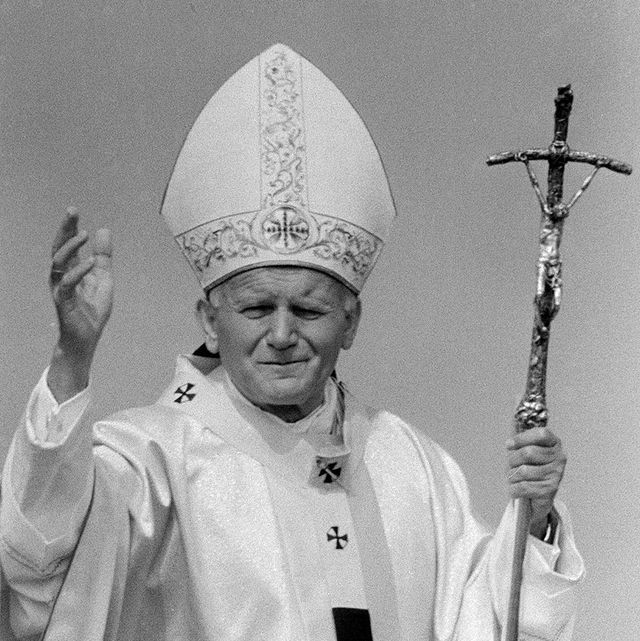
(1920-2005)
Who Was Pope John Paul II?
Pope John Paul II was ordained in 1946, became the bishop of Ombi in 1958, and became the archbishop of Krakow in 1964. He was made a cardinal by Pope Paul VI in 1967, and in 1978 became the first non-Italian pope in more than 400 years. He was a vocal advocate for human rights and used his influence to effect political change. He died in Italy in 2005. It was announced in July 2013 that he would be declared a saint in April of the following year.
Born Karol Józef Wojtyla on May 18, 1920, in Wadowice, Poland, Pope John Paul II's early life was marked by great loss. His mother died when he was nine years old, and his older brother Edmund died when he was 12.
Growing up, John Paul was athletic and enjoyed skiing and swimming. He went to Krakow's Jagiellonian University in 1938 where he showed an interest in theater and poetry. The school was closed the next year by Nazi troops during the German occupation of Poland. Wanting to become a priest, John Paul began studying at a secret seminary run by the archbishop of Krakow. After World War II ended, he finished his religious studies at a Krakow seminary and was ordained in 1946.
Rise Within the Church
John Paul spent two years in Rome where he finished his doctorate in theology. He returned to his native Poland in 1948 and served in several parishes in and around Krakow. John Paul became the bishop of Ombi in 1958 and then the archbishop of Krakow six years later. Considered one of the Catholic Church's leading thinkers, he participated in the Second Vatican Council—sometimes called Vatican II. The council began reviewing church doctrine in 1962, holding several sessions over the course of the next few years. As a member of the council, John Paul helped the church to examine its position in the world. Well regarded for his contributions to the church, John Paul was made a cardinal in 1967 by Pope Paul VI.
Becoming Pope
In 1978, John Paul made history by becoming the first non-Italian pope in more than four hundred years. As the leader of the Catholic Church, he traveled the world, visiting more than 100 countries to spread his message of faith and peace. But he was close to home when he faced the greatest threat to his life. In 1981, an assassin shot John Paul twice in St. Peter's Square in Vatican City. Fortunately, he was able to recover from his injuries and later forgave his attacker.
A vocal advocate for human rights, John Paul often spoke out about suffering in the world. He held strong positions on many topics, including his opposition to capital punishment. A charismatic figure, John Paul used his influence to bring about political change and is credited with the fall of communism in his native Poland. He was not without critics, however. Some have stated that he could be harsh with those who disagreed with him and that he would not compromise his hard-line stance on certain issues, such as contraception.
In his later years, John Paul's health appeared to be failing. At public appearances, he moved slowly and seemed unsteady on his feet. He also visibly trembled at times. One of his doctors also disclosed that John Paul had Parkinson's disease, a brain disorder often characterized by shaking, in 2001. But there was never any official announcement about his illness from the Vatican.
Pope John Paul II died on April 2, 2005, at the age of 84, at his Vatican City residence. More than 3 million people waited in line to say good-bye to their beloved religious leader at St. Peter's Basilica before his funeral on April 8.
On July 5, 2013, waving the usual five-year waiting period, the Vatican announced that the Roman Catholic Church would declare Pope John Paul II a saint and that the canonization ceremony would likely take place within the next 16 months. The Vatican also stated that Pope John XXIII, who headed the Catholic Church from 1958 until his death in 1963 and convened the Vatican II council, would also be declared a saint.
On September 30, 2013, Pope Francis announced that the canonizations of Pope John Paul II and Pope John XXIII would occur on April 27, 2014. The announcement of Pope John Paul II's canonization came after the Vatican revealed that two miracles were attributed to the late pope. After a dying French nun, Sister Marie Simon-Pierre Normand, prayed to Pope John Paul II for during her battle with Parkinson's disease—the same illness that killed the pope—she was cured. The second miracle involved a 50-year-old woman, who claimed that she was cured of a brain aneurysm after a photograph of Pope John Paul II spoke to her.
The official sainthood ceremony, held on April 27, 2014, brought together four popes. Pope Francis led the event to elevate Pope John Paul II and Pope John XXIII to sainthood, which was also attended by Francis's predecessor Emeritus Pope Benedict.
QUICK FACTS
- Birth Year: 1920
- Birth date: May 18, 1920
- Birth City: Wadowice
- Birth Country: Poland
- Gender: Male
- Best Known For: Pope John Paul II made history in 1978 by becoming the first non-Italian pope in more than 400 years.
- Christianity
- Astrological Sign: Taurus
- Krakow seminary
- Jagiellonian University
- Nacionalities
- Interesting Facts
- Pope John Paul II was the first non-Italian pope in more than 400 years.
- Death Year: 2005
- Death date: April 2, 2005
- Death City: Vatican City
- Death Country: Italy
CITATION INFORMATION
- Article Title: John Paul II Biography
- Author: Biography.com Editors
- Website Name: The Biography.com website
- Url: https://www.biography.com/religious-figure/john-paul-ii
- Access Date:
- Publisher: A&E Television Networks
- Last Updated: April 9, 2021
- Original Published Date: April 2, 2014
- As the family goes, so goes the nation, and so goes the whole world in which we live.
- The great danger for family life, in the midst of any society whose idols are pleasure, comfort and independence, lies in the fact that people close their hearts and become selfish.
- Never again war! Never again hatred and intolerance! This is the lesson taught by this century and this millennium which are now drawing to a close.
- When the light fades or vanishes altogether, we no longer see things as they really are.
- People are made for happiness.
- True joy is a victory, something which cannot be obtained without a long and difficult struggle.
- The world you are inheriting is a world which desperately needs a new sense of brotherhood and human solidarity.
- Even a tiny flame lifts the heavy lid of night.
- Although I have lived through much darkness, under harsh totalitarian regimes, I have seen enough evidence to be unshakably convinced that no difficulty, no fear is so great that it can completely suffocate the hope that springs eternal in the hearts of the young.
- Man cannot live without love. He remains a being that is incomprehensible for himself, his life is senseless, if love is not revealed to him, if he does not encounter love, if he does not experience it and make it his own, if he does not participate intimately in it.
Watch Next .css-16toot1:after{background-color:#262626;color:#fff;margin-left:1.8rem;margin-top:1.25rem;width:1.5rem;height:0.063rem;content:'';display:-webkit-box;display:-webkit-flex;display:-ms-flexbox;display:flex;}

Famous Religious Figures
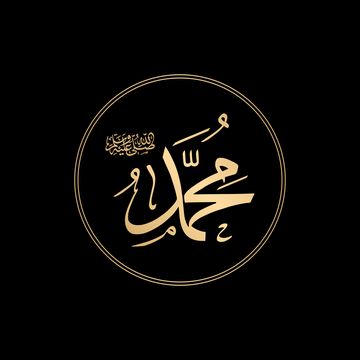
7 Little-Known Facts About Saint Patrick
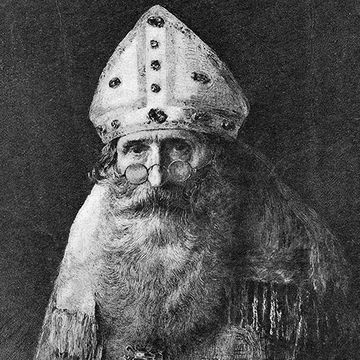
Saint Nicholas
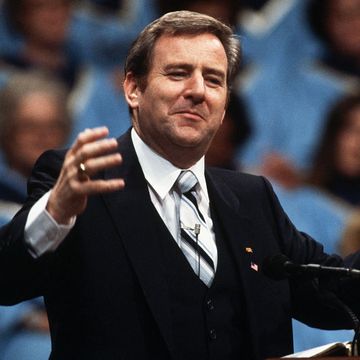
Jerry Falwell

Bhagwan Shree Rajneesh

Saint Thomas Aquinas
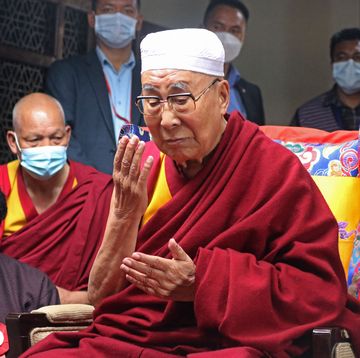
History of the Dalai Lama's Biggest Controversies
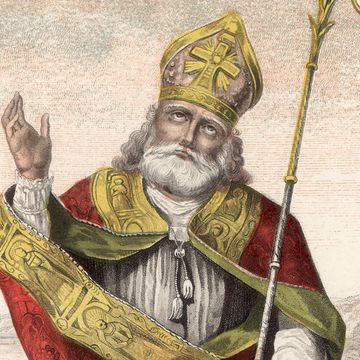
Saint Patrick

Pope Benedict XVI
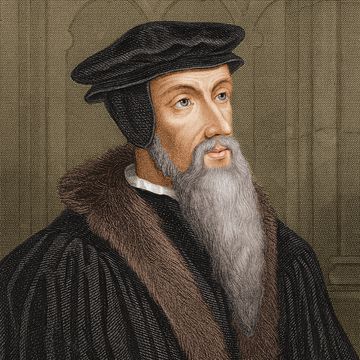
John Calvin
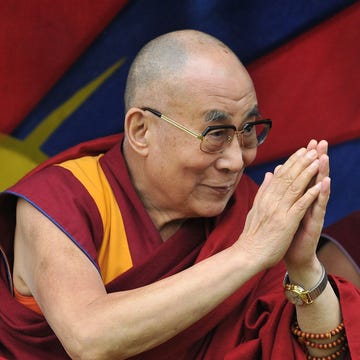
Pontius Pilate

- History & Society
- Science & Tech
- Biographies
- Animals & Nature
- Geography & Travel
- Arts & Culture
- Games & Quizzes
- On This Day
- One Good Fact
- New Articles
- Lifestyles & Social Issues
- Philosophy & Religion
- Politics, Law & Government
- World History
- Health & Medicine
- Browse Biographies
- Birds, Reptiles & Other Vertebrates
- Bugs, Mollusks & Other Invertebrates
- Environment
- Fossils & Geologic Time
- Entertainment & Pop Culture
- Sports & Recreation
- Visual Arts
- Demystified
- Image Galleries
- Infographics
- Top Questions
- Britannica Kids
- Saving Earth
- Space Next 50
- Student Center
- Introduction & Top Questions
Early life and influences
Decision to join the priesthood.
- Actions as cardinal
- Election as pope
- First year of travels
- Political and cultural messages
- World religions
- Christian ecumenism
- Ecclesiastical and theological contributions
- Final years

What were St. John Paul II’s accomplishments?
- What is the difference between Christianity and Roman Catholicism?
- Who founded Roman Catholicism?
- What are the Roman Catholic sacraments?
- Why is Roman Catholicism so prominent in Latin America?

St. John Paul II
Our editors will review what you’ve submitted and determine whether to revise the article.
- Academia - “John XXIII and John Paul II: The Human Rights Popes”
- Jewish Virtual Library - Biography of John Paul II
- The MY HERO Project - Pope John Paul II
- Saint John Paul II - Children's Encyclopedia (Ages 8-11)
- Saint John Paul II - Student Encyclopedia (Ages 11 and up)
- Table Of Contents
What is St. John Paul II known for?
John Paul II was the first non-Italian pope in 455 years. He travelled abroad extensively in an effort to promote greater understanding between countries and religions, and he campaigned against political oppression, violence, and materialism. He survived an assassination attempt in 1981.
John Paul II’s private conversations with Polish and Soviet leaders contributed to the peaceful end of the Soviet regime in eastern Europe, and his worldwide outreach brought greater visibility to the church. He engaged in acts of interfaith reconciliation with Judaism and Islam , promulgated a new catechism (1992), and canonized nearly 500 saints .
What was St. John Paul II’s legacy?
John Paul II was the first globally oriented pope, and he increased the global prestige of the papacy. His emphasis on religious and national freedom was unprecedented. He also centralized control over Catholic educational institutions and maintained traditional church positions on gender and sexual issues.
Recent News
St. John Paul II (born May 18, 1920, Wadowice, Poland—died April 2, 2005, Vatican City; beatified May 1, 2011; canonized April 27, 2014; feast day October 22) was the bishop of Rome and head of the Roman Catholic Church from 1978 to 2005. He was the first non- Italian pope in 455 years and the first from a Slavic country . His pontificate of more than 26 years was the third longest in history. As part of his effort to promote greater understanding between nations and between religions , he undertook numerous trips abroad, traveling far greater distances than had all other popes combined , and he extended his influence beyond the church by campaigning against political oppression and criticizing the materialism of the West. He also issued several unprecedented apologies to groups that historically had been wronged by Catholics, most notably Jews and Muslims . His unabashed Polish nationalism and his emphasis on nonviolent political activism aided the Solidarity movement in communist Poland in the 1980s and ultimately contributed to the peaceful dissolution of the Soviet Union in 1991. More generally, John Paul used his influence among Catholics and throughout the world to advance the recognition of human dignity and to deter the use of violence . His centralized style of church governance, however, dismayed some members of the clergy, who found it autocratic and stifling. He failed to reverse an overall decline in the numbers of priests and nuns , and his traditional interpretations of church teachings on personal and sexual morality alienated some segments of the laity.

Wojtyła’s childhood coincided with the only period of freedom that Poland would know between 1772 and 1989: the two decades between Marshal Józef Piłsudski ’s defeat of the Soviet Red Army in 1920 and the German invasion in 1939. Wojtyła thus grew up experiencing national freedom but also understanding its vulnerability. Although Wadowice, a town of about 8,000 Catholics and 2,000 Jews, lay only 15 miles (24 km) from the future site of Auschwitz , a Nazi death camp , there was apparently little anti-Semitism in the town before the war. One of Wojtyła’s close boyhood friends was a son of the leader of Wadowice’s Jewish community .
Wojtyła’s father, Karol senior, was a lieutenant in the Polish army. His mother, Emilia Kaczorowska, died when he was eight years old; his brother, Edmund, who had become a physician, died less than four years later. Wojtyła was an outgoing youth, though always with a serious side. He excelled in academics and dramatics, played football (soccer), and, under his father’s guidance, lived a disciplined life of routine religious observance. He regularly assisted Father Kazimierz Figlewicz, his confessor and first teacher in Catholicism, in Wadowice’s main church, which was next door to the Wojtyła family’s tiny apartment.
After graduating from secondary school as valedictorian, Wojtyła moved with his father to Kraków , where he attended the Jagiellonian University. His studies ended abruptly when Nazi Germany invaded Poland on September 1, 1939. In the months that followed, Jews as well as non-Jewish cultural and political leaders, including professors and priests, were killed or deported to concentration camps by the Nazis , who considered the Slavs an inferior race.

Wojtyła and his father fled with thousands to the east but soon returned after learning that the Russians had also invaded Poland. Back in Kraków, Wojtyła continued his studies in clandestine classes. For the next four years, in order to avoid arrest and deportation, he worked in a factory owned by Solvay, a chemical firm that the Nazis considered essential to their war effort. Wojtyła was thus the only pope, at least in modern times, to have been a laborer.
During these years Wojtyła began to write nationalistic plays, and he joined the Rhapsodic Theatre, an underground resistance group that aimed to sustain Polish culture and morale through covert readings of poetry and drama. Through Jan Tyranowski, a tailor who conducted a youth ministry for the local church, Wojtyła was introduced to the teachings of St. John of the Cross , a Carmelite mystic who held that redemption could be gained through suffering and a “spirituality of abandonment.” Tyranowski’s example helped to convince Wojtyła that the church, even more than a renewed Polish theater, might improve the world. Wojtyła’s confessor continued to be his childhood mentor, Figlewicz, who had transferred to Wawel Cathedral in Kraków.
In February 1941 Wojtyła returned from work one day to discover that his father had died alone; he prayed by the body all night. By the autumn of 1942 he had decided to enter the priesthood. For two years, while still working at the chemical factory, he attended illegal seminary classes run by Kraków’s cardinal archbishop, Prince Adam Sapieha . After narrowly escaping a Nazi roundup of able-bodied men and boys in 1944, Wojtyła spent the rest of the war in the archbishop’s palace, disguised as a cleric. As pope, Wojtyła recalled that witnessing Nazi horrors, including the murder of many priests, showed him the real meaning of the priesthood.
In 1945 the Soviets replaced the Germans as occupiers of Poland. In November 1946 Wojtyła was ordained by Sapieha into the Catholic priesthood. He chose to say his first mass , assisted by Figlewicz, in Wawel Cathedral’s crypt chapel amid the sarcophagi of Polish monarchs and heroes, including those who had defended national freedom and European Christendom. He then began two years of study in Rome, where he completed his first doctorate, an examination of the theology of St. John of the Cross. Assigned to Kraków’s St. Florian’s parish in 1949, he studied, wrote, and lectured on philosophy and social and sexual ethics . During the next decade he completed a second doctorate, taught theology and ethics at the Jagiellonian University, and eventually was appointed to a full professorship at the Catholic University of Lublin .
The young priest wrote poetry, published anonymously, on a variety of religious, social, and personal themes. He also became the spiritual leader and mentor of a circle of young adult friends whom he joined on kayaking and camping trips. Together, they celebrated mass in the open at a time when unapproved worship outside of churches was forbidden by the communist regime. Experiences with these friends contributed to the ideas in his first book of nonfiction, Love and Responsibility (1960), an exploration of the several graces available in conjugal sexual relationships. The work was considered radical by those who held the traditional church view that sex was solely for the purpose of procreation.
Church leaders were impressed by Wojtyła’s ability to operate a dynamic pastorate despite communist restrictions. In 1958 Pope Pius XII appointed him an auxiliary bishop of Kraków. At the Second Vatican Council (1962–65) Wojtyła so distinguished himself that halfway through the council, in December 1963, Pope Paul VI named him archbishop of Kraków.
The Second Vatican Council introduced Wojtyła to issues including the role of the laity, the church’s relations with other religions, and its relations with the secular world. After the council’s conclusion in 1965, Wojtyła was appointed to Pope Paul VI ’s Commission for the Study of Problems of the Family, Population, and Birth Rate. His work appears to have influenced Humanae vitae (1968; “Of Human Life”), Paul VI’s encyclical rejecting artificial contraception , which became one of the church’s most ignored teachings. Some bishops also disagreed with it, saying privately that, on this issue, Wojtyła may have made basic theological mistakes.
- Biographies & Memoirs
- Community & Culture

Sorry, there was a problem.

Download the free Kindle app and start reading Kindle books instantly on your smartphone, tablet or computer – no Kindle device required .
Read instantly on your browser with Kindle for Web.
Using your mobile phone camera, scan the code below and download the Kindle app.

Image Unavailable

- To view this video, download Flash Player
Follow the author

Witness to Hope: The Biography of Pope John Paul II Paperback – March 3 2020
Purchase options and add-ons.
INTERNATIONAL BESTSELLER
"A remarkable book. Weigel's biography is likely to remain the standard one-volume reference on John Paul II for many years to come." — Pittsburg Post-Gazette
? “Fascinating. . . sheds light on the history of the twentieth century for everyone.” — New York Times Book Review
The definitive biography of Pope John Paul II that explores how influential he was on the world stage and in some of the most historic events of the twentieth century that can still be felt today
Witness to Hope is the authoritative biography of one of the singular figures—some might argue the singular figure—of our time. With unprecedented cooperation from John Paul II and the people who knew and worked with him throughout his life, George Weigel offers a groundbreaking portrait of the Pope as a man, a thinker, and a leader whose religious convictions defined a new approach to world politics—and changed the course of history. As even his critics concede, John Paul II occupied a unique place on the world stage and put down intellectual markers that no one could ignore or avoid as humanity entered a new millennium fraught with possibility and danger.
The Pope was a man of prodigious energy who played a crucial, yet insufficiently explored, role in some of the most momentous events of our time, including the collapse of European communism, the quest for peace in the Middle East, and the democratic transformation of Latin America. With an updated preface, this edition of Witness to Hope explains how this “man from a far country” did all of that, and much more—and what both his accomplishments and the unfinished business of his pontificate mean for the future of the Church and the world.
- Print length 1056 pages
- Language English
- Publisher Harper Perennial
- Publication date March 3 2020
- Dimensions 15.54 x 4.32 x 23.16 cm
- ISBN-10 0062996010
- ISBN-13 978-0062996015
- See all details
Frequently bought together

Customers who bought this item also bought

From the Publisher

At HarperCollins, authors and their work are at the center of everything we do. We are proud to provide our authors with unprecedented editorial excellence, marketing reach, long-standing connections with booksellers, and insight into reader and consumer behavior. Consistently at the forefront of innovation and technological advancement, HarperCollins also uses digital technology to create unique reading experiences and expand the reach of our authors.
HarperCollins was founded by brothers James and John Harper in New York City in 1817 as J. and J. Harper, later Harper & Brothers. In 1987, as Harper & Row, it was acquired by News Corporation. The worldwide book group was formed following News Corporation's 1990 acquisition of the British publisher William Collins & Sons. Founded in 1819, William Collins & Sons published a range of Bibles, atlases, dictionaries, and reissued classics, expanding over the years to include legendary authors such as H. G. Wells, Agatha Christie, J. R. R. Tolkien, and C. S. Lewis.
The house of Mark Twain, the Brontë sisters, Thackeray, Dickens, John F. Kennedy, Martin Luther King Jr., Maurice Sendak, Shel Silverstein, and Margaret Wise Brown, HarperCollins has a long and rich history that reaches back to the early nineteenth century and offers our publishing team a depth of experience.
Product description
"A remarkable book. Weigel's biography is likely to remain the standard one-volume reference on John Paul II for many years to come." — Pittsburg Post-Gazette
"A fascinating chronicle. . . sheds light on the history of the twentieth century for everyone." — New York Times Book Review
“Magnificent. A tremendous achievement.” — Washington Post
"It is no mean feat to undertake the momentous task of chronicling the life and witness of a man whose presence has helped to change the course of history. Witness to Hope is a meticulously researched book that is certain to become a benchmark for future inquiries into the life and times of Pope John Paul II." — Los Angeles Times
"Anchored in a careful examination of the Pope's documents, Weigel helps us understand the spiritual and philosophical convictions that drive John Paul forward. This is the great contribution of Witness to Hope ." — National Catholic Reporter
"Weigel's biography is outstanding—positive but not uncritical. [It] will be the definitely work on the Pope. — Buffalo News
"A meticulous chronicle. It is Weigel's gift to be able to interleaf the spiritual and secular aspects of Wojtyla's education so seamlessly that his life in the Church takes on political overtones practically from the beginning. . . . One of the most interesting histories of our time." — Boston Globe
“An indispensable source for all those studying the consequences and impact of this pontificate.” — Il Tempo (Rome)
“The first true biography of the last giant of the century.” — L’Express (Paris)
"Like the man it reflects, the book is complex, and it's engaging. Weigel composes a multilayered story of Karol Wojtyla's life that is accessible to all." — Chicago Daily Herald
"Massive in scope and length, and written with the Pope's cooperation, Weigel's biography is sure to be the definitive work on Pope John Paul II for years to come." — Kirkus Reviews
"By far the best biography of John Paul II. . . . An indispensable reference source for future historians." — Washington Times
"Weigel's book is not only a major piece of scholarship but a cracking good story. Rarely has there been so perfect a marriage of man to job as Karol Wojtyla to the papacy. He was appointed at just the right time, and he has met his obligations superbly. The same may be said for his biographer." — National Review
“A profound analysis of all the important issues.... A marvelous work and a pleasure to read.” — ABC (Madrid)
About the Author
George Weigel is one of the world's foremost authorities on the Catholic Church and the author of the New York Times bestseller Witness to Hope: The Biography of Pope John Paul II . He is a Senior Fellow of the Ethics and Public Policy Center in Washington, D.C., and a consultant on Vatican affairs for NBC News.
Product details
- Publisher : Harper Perennial (March 3 2020)
- Language : English
- Paperback : 1056 pages
- ISBN-10 : 0062996010
- ISBN-13 : 978-0062996015
- Item weight : 998 g
- Dimensions : 15.54 x 4.32 x 23.16 cm
- #224 in Feminist Christian Theology
- #227 in Feminist Theology
- #514 in Christian Faith (Books)
About the author
George weigel.
George Weigel, Distinguished Senior Fellow of the Ethics and Public Policy Center, is a Catholic theologian and one of America’s leading public intellectuals. He holds the William E. Simon Chair in Catholic Studies at the Ethics and Public Policy Center in Washington, DC.
From 1989 through June 1996, Mr. Weigel was president of the Ethics and Public Policy Center, where he led a wide-ranging, ecumenical and inter-religious program of research and publication on foreign and domestic policy issues.
Mr. Weigel is perhaps best known for his widely translated and internationally acclaimed two-volume biography of Pope St. John Paul II: the New York Times bestseller, Witness to Hope (1999), and its sequel, The End and the Beginning (2010). In 2017, Weigel published a memoir of the experiences that led to his work as a papal biographer: Lessons in Hope — My Unexpected Life with St. John Paul II.
George Weigel is the author or editor of more than thirty other books, many of which have been translated into other languages. Among the most recent are The Cube and the Cathedral: Europe, America, and Politics Without God (2005); Evangelical Catholicism: Deep Reform in the 21st-Century Church (2013); Roman Pilgrimage: The Station Churches (2013); Letters to a Young Catholic (2015); The Fragility of Order: Catholic Reflections on Turbulent Times (2018); The Next Pope: The Office of Peter and a Church in Mission (2020); and Not Forgotten: Elegies for, and Reminiscences of, a Diverse Cast of Characters, Most of Them Admirable (2021). His essays, op-ed columns, and reviews appear regularly in major opinion journals and newspapers across the United States. A frequent guest on television and radio, he is also Senior Vatican Analyst for NBC News. His weekly column, “The Catholic Difference,” is syndicated to eighty-five newspapers and magazines in seven countries.
Mr. Weigel received a B.A. from St. Mary’s Seminary and University in Baltimore and an M.A. from the University of St. Michael’s College, Toronto. He is the recipient of nineteen honorary doctorates in fields including divinity, philosophy, law, and social science, and has been awarded the Papal Cross Pro Ecclesia et Pontifice, Poland’s Gloria Artis Gold Medal, and Lithuania’s Diplomacy Star.
Customer reviews
- 5 star 4 star 3 star 2 star 1 star 5 star 86% 9% 2% 2% 0% 86%
- 5 star 4 star 3 star 2 star 1 star 4 star 86% 9% 2% 2% 0% 9%
- 5 star 4 star 3 star 2 star 1 star 3 star 86% 9% 2% 2% 0% 2%
- 5 star 4 star 3 star 2 star 1 star 2 star 86% 9% 2% 2% 0% 2%
- 5 star 4 star 3 star 2 star 1 star 1 star 86% 9% 2% 2% 0% 0%
- Sort reviews by Top reviews Most recent Top reviews
Top reviews from Canada
There was a problem filtering reviews right now. please try again later..
5 ways Saint Pope John Paul II changed the Catholic Church forever
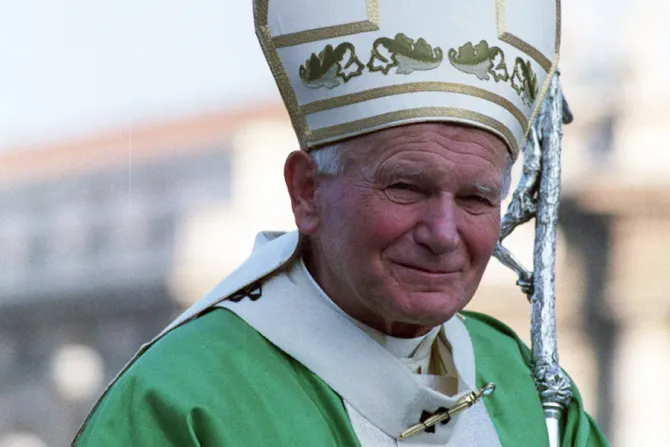
By CNA Staff
Vatican City, Oct 22, 2021 / 16:10 pm
You probably know that St. Pope John Paul II was the second longest-serving pope in modern history with 27 years of pontificate, and he was the first non-Italian pontiff since the Dutch Pope Adrian VI in 1523. But did you know that he changed the Catholic Church forever during those 27 years? Here are five reasons why:
1. He helped bring about the 1989 fall of communism in Eastern Europe.
The pope’s official biographer, George Weigel, who for decades chronicled the pope’s engagement with civic leaders, noted that the way Pope John Paul II influenced the political landscape was enormous. His political influence is seen best in the way his engagement with world leaders assisted the downfall of the U.S.S.R.
Just days before President Ronald Reagan called on Mikhail Gorbachev to “tear down” the Berlin Wall, he met with the pope. According to historian and author Paul Kengor, Reagan went so far as to call Pope John Paul II his “best friend,” opining that no one knew his soul better than the Polish pontiff who had also suffered an assasination attempt and carried the burden of world leadership.
In the course of 38 official visits and 738 audiences and meetings held with heads of state, John Paul II influenced civic leaders around the world in this epic battle with a regime that would ultimately be responsible for the deaths of more than 30 million people.
“He thought of himself as the universal pastor of the Catholic Church, dealing with sovereign political actors who were as subject to the universal moral law as anybody else,” Weigel said.
“He was willing to be a risk-taker, but he also appreciated that prudence is the greatest of political virtues. And I think he was quite respected by world political leaders because of his transparent integrity. His essential attitude toward these men and women was: How can I help you? What can I do to help?”
More than anything, John Paul II understood his role primarily as a spiritual leader.
According to Weigel, the pope’s primary impact on the world of affairs was his central role in creating the revolution of conscience that began in Poland and swept across Eastern Europe. This revolution of conscience inspired the nonviolent revolution of 1989 and the collapse of Communism in Central and Eastern Europe, an astounding political achievement.
More in Vatican

Pope Francis reflects with wonder on ‘the miracle of the Eucharist’
2. He beatified and canonized more saints than any predecessor, making holiness more accessible to ordinary people.
One of John Paul II’s most enduring legacies is the huge number of saints he recognized. He celebrated 147 beatification ceremonies during which he proclaimed 1,338 blesseds, as well as celebrating 51 canonizations for a total of 482 saints. That is more than the combined tally of his predecessors over the five centuries before.
Mother Teresa of Calcutta is perhaps the most well-known contemporary of John Paul II who is now officially a saint, but the first saint of the new millennium and one especially dear to John Paul II was St. Faustina Kowalska, the fellow Polish native who received the message of Divine Mercy.
“Sr. Faustina's canonization has a particular eloquence: by this act I intend today to pass this message on to the new millennium,” he said in the homily of her canonization. “I pass it on to all people, so that they will learn to know ever better the true face of God and the true face of their brethren.”
Pier Giorgio Frassati, whom Pope John Paul II beatified in 1990 and nicknamed the “man of the beatitudes,” is another popular saint elevated by the Polish Pope who loved to recognize the holiness of simple persons living the call to holiness with extraordinary fidelity. At the time of his death, the 24 year-old Italian was simply a student with no extraordinary accomplishments. But his love for Christ in the Eucharist and in the poor was elevated by John Paul II as heroic and worthy of imitation.
It bears noting that Pope Francis would later surpass John Paul II when he proclaimed 800 Italian martyrs saints in a single day.
3. He transformed the papal travel schedule.
(Story continues below)
Subscribe to our daily newsletter
John Paul II visited some 129 counties during his pontificate — more countries than any other pope had visited up to that point.
He also created World Youth Days in 1985, and presided over 19 of them as pope.
Weigel says John Paul II understood that the pope must be present to the people of the Church, wherever they are.
“He chose to do it by these extensive travels, which he insisted were not travels, they were pilgrimages,” Wegel said.
“This was the successor of Peter, on pilgrimage to various parts of the world, of the Church. And that's why these pilgrimages were always built around liturgical events, prayer, adoration of the Holy Eucharist, ecumenical and interreligious gatherings — all of this was part of a pilgrimage experience.”
In the latter half of the 20th century — a time of enormous social change and upheaval— John Paul II’s extensive travels and proclamation of the Gospel to the ends of the earth were just what the world needed, Weigel said.
4. He transformed the teachings of the Church.
John Paul II was a scholar who promulgated the Catechism of the Catholic Church in 1992, reformed the Eastern and Western Codes of Canon Law during his pontificate, and authored 14 encyclicals, 15 apostolic exhortations, 11 apostolic constitutions, and 45 apostolic letters.
This is why Weigel says the Church has really only begun to unpack what he calls the “magisterium” of John Paul II, in the form of his writings and his intellectual influence.
For example, John Paul’s Theology of the Body remains enormously influential in the United States and throughout the world, though Weigel says even this has yet to be unpacked.
5. He gave new life to the Catholic Church in Africa.
John Paul II’s legendary evangelical fervor took fire in Africa.
He had a particular friendship with Beninese Cardinal Bernadin Gantin, and visited Africa many times. His visits would inspire a generation of JPII Catholics in Africa as well other parts of the globe.
“John Paul II was fascinated by Africa; he saw African Christianity as living, a kind of New Testament experience of the freshness of the Gospel, and he was very eager to support that, and lift it up,” Cardinal Gantin said.
“It was very interesting that during the two synods on marriage and the family in 2014 and 2015, some of the strongest defenses of the Church's classic understanding of marriage and family came from African bishops. Some of whom are first, second generation Christians, deeply formed in the image of John Paul II, whom they regard as a model bishop,” Gantin said.
“I think wherever you look around the world Church, the living parts of the Church are those that have accepted the Magisterium of John Paul II and Benedict XVI as the authentic interpretation of Vatican II. And the dying parts of the Church, the moribund parts of the Church are those parts that have ignored that Magisterium.”
John Paul II’s influence in Africa and around the globe transformed the world. It also forever transformed the Church.
- Catholic News ,
- Catholic Church ,
- Pope St. John Paul II

Our mission is the truth. Join us!
Your monthly donation will help our team continue reporting the truth, with fairness, integrity, and fidelity to Jesus Christ and his Church.

You may also like
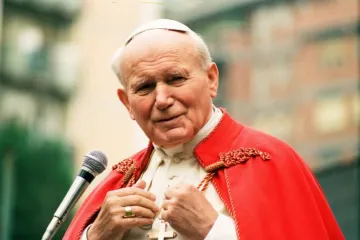
Could St. John Paul II be declared a Doctor of the Church?
The Polish bishops’ conference made a formal request in 2019.

When Was Baseball’s Golden Age?
George weigel.

To Sanctify the World: The Vital Legacy of Vatican II
Witness to Hope: The Biography of Pope John Paul II

Buy the Book
Biographies & memoirs.
“Fascinating…sheds light on the history of the twentieth century for everyone.”— New York Times Book Review
Now, with an updated preface, the latest edition of the definitive biography of Pope John Paul II that explores how influential he was on the world stage and in some of the most historic events of the twentieth century that can still be felt today.
Witness to Hope is the authoritative biography of one of the singular figures—some might argue the singular figure—of our time. With unprecedented cooperation from John Paul II and the people who knew and worked with him throughout his life, George Weigel offers a groundbreaking portrait of the Pope as a man, a thinker, and a leader whose religious convictions defined a new approach to world politics—and changed the course of history. As even his critics concede, John Paul II occupied a unique place on the world stage and put down intellectual markers that no one could ignore or avoid as humanity entered a new millennium fraught with possibility and danger.
The Pope was a man of prodigious energy who played a crucial, yet insufficiently explored, role in some of the most momentous events of our time, including the collapse of European communism, the quest for peace in the Middle East, and the democratic transformation of Latin America. With an updated preface, this edition of Witness to Hope explains how this “man from a far country” did all of that, and much more—and what both his accomplishments and the unfinished business of his pontificate mean for the future of the Church and the world.
Books by George Weigel
- Biographies & Memoirs
- Catholicism
- Essay Compilations
- Foreign Affairs
- Literature and Literary Personalities
- Politics and Social Sciences

Email: [email protected]
Sign up here to receive The Catholic Difference and other materials from George Weigel straight to your inbox
The catholic difference, catholic & vatican affairs, international affairs, u.s. affairs, john paul ii.
Author Website Design by Rocket Expansion

a, known as John Paul II since his October 1978 election to the papacy, was born in Wadowice, a small city 50 kilometres from Cracow, on May 18, 1920. He was the second of two sons born to Karol Wojty a and Emilia Kaczorowska. His mother died in 1929. His eldest brother Edmund, a doctor, died in 1932 and his father, a non-commissioned army officer died in 1941. He made his First Holy Communion at age 9 and was confirmed at 18. Upon graduation from high school in Wadowice, he enrolled in Cracow's Jagiellonian University in 1938 and in a school for drama. chemical factory to earn his living and to avoid being deported to Germany. In 1942, aware of his call to the priesthood, he began courses in the clandestine seminary of Cracow, run by Cardinal Adam Stefan Sapieha, archbishop of Cracow. At the same time, Karol Wojty a was one of the pioneers of the "Rhapsodic Theatre," also clandestine. After the Second World War, he continued his studies in the major seminary of Cracow, once it had re-opened, and in the faculty of theology of the Jagiellonian University, until his priestly ordination in Cracow on November 1, 1946. Soon after, Cardinal Sapieha sent him to Rome where he worked under the guidance of the French Dominican, Garrigou-Lagrange. He finished his doctorate in theology in 1948 with a thesis on the topic of faith in the works of St. John of the Cross. At that time, during his vacations, he exercised his pastoral ministry among the Polish immigrants of France, Belgium and Holland. In 1948 he returned to Poland and was vicar of various parishes in Cracow as well as chaplain for the university students until 1951, when he took up again his studies on philosophy and theology. In 1953 he defended a thesis on "evaluation of the possibility of founding a Catholic ethic on the ethical system of Max Scheler" at Lublin Catholic University. Later he became professor of moral theology and social ethics in the major seminary of Cracow and in the Faculty of Theology of Lublin.
On January 13, 1964, he was nominated Archbishop of Cracow by Pope Paul VI, who made him a cardinal June 26, 1967. Besides taking part in Vatican Council II with an important contribution to the elaboration of the Constitution , Cardinal Wojty a participated in all the assemblies of the Synod of Bishops. His principal documents include 14 encyclicals, 15 apostolic exhortations, 11 apostolic constitutions and 44 apostolic letters. The Pope's books include: "Crossing the Threshold of Hope" (October 1994); "Gift and Mystery: On the 50th Anniversary of My Priestly Ordination" (November 1996); "Roman Triptych - Meditations", a book of poems (March 2003); "Rise, Let Us Be On Our Way" (May 2004) and "Memory and Identity" (publication spring 2005). ) cardinals. He has also convened six plenary meetings of the College of Cardinals. From 1978 to today the Holy Father has presided at 15 Synods of Bishops: six ordinary (1980, 1983, 1987, 1990, 1994, 2001), one extraordinary (1985) and eight special (1980, 1991, 1994, 1995, 1997, 1998[2] and 1999). |
Biography Online

Biography Pope John Paul II
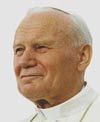
“Strengthen the bonds that unite us and eliminate all that has divided us in the past.”
– Pope John Paul II
Early Life Karol Wojtyla
Born in Poland, 18th May 1920, Karol Wojtyla was brought up in a turbulent period. As a young man, he lived through the brutal Nazi occupation of Poland. He witnessed many atrocities and on occasions narrowly avoided with his life. It was during the war that he made the decision to train to be a priest; this had to be done clandestinely. During the war, he was also credited with trying to help Jewish friends escape persecution.
The defeat of Nazi Germany saw Poland suffer under a new occupation. Though much less brutal, the Communist state was suspicious of the Catholic church and Karol was frequently bugged by state officials. Nevertheless, the young Pope developed a good reputation. He had intelligence, charisma and inspired many of his young students. His sharp intellect and practical understanding led to his rapid promotion within the Catholic clergy. At the age of 38, he was made the youngest bishop in Poland.
Starting in October 1962, Bishop Wojtyla participated in the groundbreaking – Second Vatican Council which re-evaluated Catholic practises.
Election to Pope
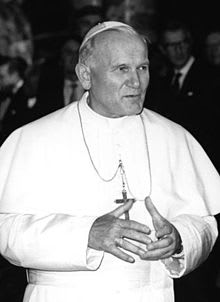
Pope John Paul II (1980)
In 1978 after the death of Pope Paul VI and John Paul I (after only 33 days), Karol was elected pope making him one of the youngest pope’s and the first pope from Poland.
It was rather a surprise for John Paul. He accepted the position with humility
‘With obedience in faith to Christ, my Lord, and with trust in the Mother of Christ and the Church, in spite of great difficulties, I accept.’
Pope John Paul soon put his mark on the papacy. He travelled widely and frequently to over 120 countries. His first visit to Poland in 1978 was a sensation with huge crowds everywhere. It was credited with sparking the solidarity movement of 1980 and providing moral support for those seeking to end Soviet rule.
Pope John Paul and fall of Berlin Wall
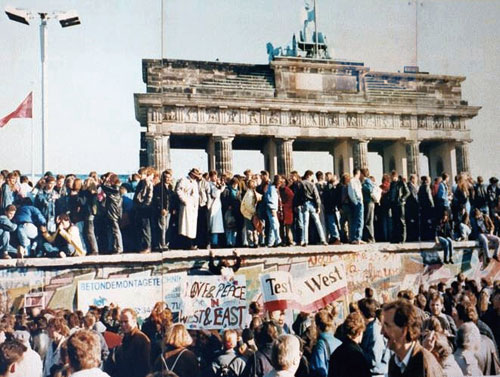
“Everything that happened in Eastern Europe in these last few years would have been impossible without the presence of this Pope and without the important role, including the political role, that he played on the world stage.”
Pope John Paul also made a historic visit to South Africa in 1995, he had promised he would not visit South Africa until the system of apartheid was ended. He was met at the airport by Nelson Mandela . Mandela greeted him with the words
“To say your visit is long overdue is to pay tribute to you own abhorrence of the system of apartheid. You delayed your visit to this country because you viewed with disdain a system that treated God’s children as lesser human beings.”
Pope John Paul II and Mother Teresa
Mother Teresa and John Paul were close to each other and full of admiration for their respective services. In 1994, Time magazine asked Mother Teresa for her assessment of John Paul, she replied:
Ever sustained by a profound faith, Nourished by unceasing prayer, Fearless in unshakeable Hope, Deeply in Love with God.”
After Mother Teresa’s death, Pope John Paul II pushed for her canonisation. Pope John Paul made the most number of saints during his papacy. He was key in giving legitimacy to Maria Faustina (a Polish mystic) and Padre Pio (a charismatic Italian mystic)
Pope John Paul II and Other Religions
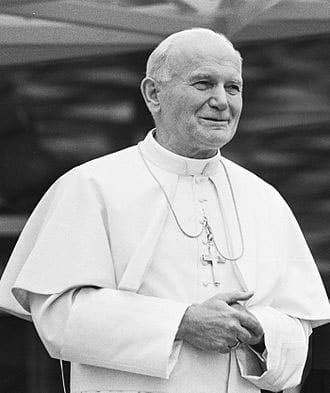
In particular, his apology for anti-semitic acts in the past encouraged better relationships between Jews and Catholics.
“We are deeply saddened by the behaviour of those who in the course of history have caused these children of yours to suffer, and asking your forgiveness we wish to commit ourselves to genuine brotherhood with the people of the Covenant.”
—Pope John Paul II (12 March 2000)
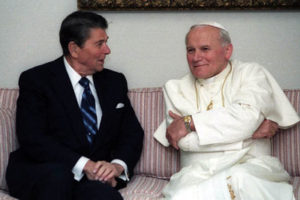
Pope John Paul II and Ronald Reagan.
The pope made over 100 apologies for various misdeeds such as women, Galileo, role in slavery, and the silence of Catholics during the holocaust. Pope John Paul II made an important visit to Greece in 2001. He was the first pope to visit the country in 1,291 years. He met the head of the Church of Greece and offered an apology for past misdeeds of the Catholic Church such as the sack of Constantinople. The two leaders shared a common declaration of supporting Christianity in Europe and avoiding ‘all recourse to violence, proselytism and fanaticism, in the name of religion.’ In the same year, he became the first pope to pray in a mosque (in Damascus, Syria). He kissed the Qu’ran, an act that was appreciated by many Muslims, though he was criticised by more conservative elements within the Catholic Church.
Devotion to Mary
Pope John Paul II had a deep devotion to the Virgin Mary. During his papacy, he visited Lourdes and Fatima. In 1981, someone made an assassination attempt, and although shot, the Pope survived. He credited his survival to the intervention of Our Lady of Fatima, noting it happened on the sixtieth anniversary of the Fatima apparitions. He was the first pope to have the Virgin Mary’s initials added to his banner.
The pope later met his assassin, Mehmet Ali Agca, in prison and offered him forgiveness.
Pope on Moral Issues
On moral issues, the Pope was a conservative. He opposed the death penalty, abortion, contraception, female priests and homosexual marriages. He was criticised for his opposition to the use of condoms to fight STD such as AIDS.
He was opposed to the Iraq war in 2003, saying the United Nations should be involved in resolving conflict not unilateral force
“Wars generally do not resolve the problems for which they are fought and therefore… prove ultimately futile.” ”
— Pope John Paul II
Towards the end of his life he was diagnosed with Parkinson’s disease. In 2005, his health rapidly deteriorated – suffering from influenza, a urinary tract infection, septic shock and low blood pressure. On 2 April 2005, he said his final words “Allow me to depart to the house of the Father” and he died later in the day, aged 84 years old.
Canonisation
John Paul II was canonised by Pope Francis on 27 April 2014. His ‘feast-day’ is 22 October – to mark the date he was elected Pope.
Citation: Pettinger, Tejvan . “ Biography of Pope John Paul II ”, Oxford, UK – www.biographyonline.net . Published 19 May 2013. Last updated 14 February 2018.
The Biography of Pope John Paul II

The Biography of Pope John Paul II at Amazon
Related pages

- Kindle Store
- Kindle eBooks
- Biographies & Memoirs

| Digital List Price: | $23.99 |
| Kindle Price: | $14.39 Save $9.60 (40%) | Amazon.com Services LLC |
Promotions apply when you purchase
These promotions will be applied to this item:
Some promotions may be combined; others are not eligible to be combined with other offers. For details, please see the Terms & Conditions associated with these promotions.
Buy for others
Buying and sending ebooks to others.
- Select quantity
- Buy and send eBooks
- Recipients can read on any device
These ebooks can only be redeemed by recipients in the US. Redemption links and eBooks cannot be resold.
Sorry, there was a problem.

Download the free Kindle app and start reading Kindle books instantly on your smartphone, tablet, or computer - no Kindle device required .
Read instantly on your browser with Kindle for Web.
Using your mobile phone camera - scan the code below and download the Kindle app.

Image Unavailable

- To view this video download Flash Player
Follow the author

Witness to Hope: The Biography of Pope John Paul II Kindle Edition
- Print length 1056 pages
- Language English
- Sticky notes On Kindle Scribe
- Publisher HarperCollins e-books
- Publication date October 13, 2009
- File size 71786 KB
- Page Flip Enabled
- Word Wise Enabled
- Enhanced typesetting Enabled
- See all details

Customers who bought this item also bought

Editorial Reviews
Amazon.com review.
According to Weigel, the Pope told him that other biographies "try to understand me from outside. But I can only be understood from inside." Unfortunately, Weigel's method for understanding the Pope "from inside" depends on psychological conjecture ("It may help to begin by thinking of Karol Wojtyla as a man who grew up very fast") and is weakened by his extreme eagerness to praise his subject ("the man with arguably the most coherent and comprehensive vision of the human possibility in the world ahead"). More troubling, Weigel does not ask some of the really difficult questions about this Pope--regarding his involvement with sects such as Opus Dei, for example, or the relationship between his innovative "theology of the body" and his conservative stance on homosexuality, or even the vicissitudes of prayer life. Witness To Hope is a valuable book because it reports many facts that others have not reported. But for incisive analysis of this Pope's theological and political significance, or for insight into his spiritual life, readers will have to wait until the principals in his life story are free to speak more frankly with some future biographer. --Michael Joseph Gross
From Publishers Weekly
From booklist, from kirkus reviews.
"A remarkable book. Weigel's biography is likely to remain the standard one-volume reference on John Paul II for many years to come." — Pittsburg Post-Gazette
"A fascinating chronicle. . . sheds light on the history of the twentieth century for everyone." — New York Times Book Review
“Magnificent. A tremendous achievement.” — Washington Post
"It is no mean feat to undertake the momentous task of chronicling the life and witness of a man whose presence has helped to change the course of history. Witness to Hope is a meticulously researched book that is certain to become a benchmark for future inquiries into the life and times of Pope John Paul II." — Los Angeles Times
"Anchored in a careful examination of the Pope's documents, Weigel helps us understand the spiritual and philosophical convictions that drive John Paul forward. This is the great contribution of Witness to Hope ." — National Catholic Reporter
"Weigel's biography is outstanding—positive but not uncritical. [It] will be the definitely work on the Pope. — Buffalo News
"A meticulous chronicle. It is Weigel's gift to be able to interleaf the spiritual and secular aspects of Wojtyla's education so seamlessly that his life in the Church takes on political overtones practically from the beginning. . . . One of the most interesting histories of our time." — Boston Globe
“An indispensable source for all those studying the consequences and impact of this pontificate.” — Il Tempo (Rome)
“The first true biography of the last giant of the century.” — L’Express (Paris)
"Like the man it reflects, the book is complex, and it's engaging. Weigel composes a multilayered story of Karol Wojtyla's life that is accessible to all." — Chicago Daily Herald
"Massive in scope and length, and written with the Pope's cooperation, Weigel's biography is sure to be the definitive work on Pope John Paul II for years to come." — Kirkus Reviews
"By far the best biography of John Paul II. . . . An indispensable reference source for future historians." — Washington Times
"Weigel's book is not only a major piece of scholarship but a cracking good story. Rarely has there been so perfect a marriage of man to job as Karol Wojtyla to the papacy. He was appointed at just the right time, and he has met his obligations superbly. The same may be said for his biographer." — National Review
“A profound analysis of all the important issues.... A marvelous work and a pleasure to read.” — ABC (Madrid)
From the Back Cover
The Definitive Biography of Pope John Paul II
Witness to Hope is the authoritative biography of one of the singular figures -- some might argue the singular figure -- of our time. With unprecedented cooperation from John Paul II and the people who knew and worked with him throughout his life, George Weigel offers a groundbreaking portrait of the Pope as a man, a thinker, and a leader whose religious convictions defined a new approach to world politics -- and changed the course of history. As even his critics concede, John Paul II occupied a unique place on the world stage and put down intellectual markers that no one could ignore or avoid as humanity entered a new millennium fraught with possibility and danger.
The Pope was a man of prodigious energy who played a crucial yet insufficiently explored role in some of the most momentous events of our time, including the collapse of European communism, the quest for peace in the Middle East, and the democratic transformation of Latin America. This updated edition of Witness to Hope explains how this "man from a far country" did all of that, and much more -- and what both his accomplishments and the unfinished business of his pontificate mean for the future of the Church and the world.
About the Author
George Weigel is one of the world's foremost authorities on the Catholic Church and the author of the New York Times bestseller Witness to Hope: The Biography of Pope John Paul II . He is a Senior Fellow of the Ethics and Public Policy Center in Washington, D.C., and a consultant on Vatican affairs for NBC News.
From The Washington Post
Product details.
- ASIN : B000FCK6UW
- Publisher : HarperCollins e-books; Updated edition (October 13, 2009)
- Publication date : October 13, 2009
- Language : English
- File size : 71786 KB
- Text-to-Speech : Enabled
- Screen Reader : Supported
- Enhanced typesetting : Enabled
- X-Ray : Enabled
- Word Wise : Enabled
- Sticky notes : On Kindle Scribe
- Print length : 1056 pages
- Page numbers source ISBN : 0062996010
- #21 in Biographies of Catholicism
- #28 in Christian Papacy
- #34 in Roman Catholicism (Kindle Store)
About the author
George weigel.
George Weigel, Distinguished Senior Fellow of the Ethics and Public Policy Center, is a Catholic theologian and one of America’s leading public intellectuals. He holds the William E. Simon Chair in Catholic Studies at the Ethics and Public Policy Center in Washington, DC.
From 1989 through June 1996, Mr. Weigel was president of the Ethics and Public Policy Center, where he led a wide-ranging, ecumenical and inter-religious program of research and publication on foreign and domestic policy issues.
Mr. Weigel is perhaps best known for his widely translated and internationally acclaimed two-volume biography of Pope St. John Paul II: the New York Times bestseller, Witness to Hope (1999), and its sequel, The End and the Beginning (2010). In 2017, Weigel published a memoir of the experiences that led to his work as a papal biographer: Lessons in Hope — My Unexpected Life with St. John Paul II.
George Weigel is the author or editor of more than thirty other books, many of which have been translated into other languages. Among the most recent are The Cube and the Cathedral: Europe, America, and Politics Without God (2005); Evangelical Catholicism: Deep Reform in the 21st-Century Church (2013); Roman Pilgrimage: The Station Churches (2013); Letters to a Young Catholic (2015); The Fragility of Order: Catholic Reflections on Turbulent Times (2018); The Next Pope: The Office of Peter and a Church in Mission (2020); and Not Forgotten: Elegies for, and Reminiscences of, a Diverse Cast of Characters, Most of Them Admirable (2021). His essays, op-ed columns, and reviews appear regularly in major opinion journals and newspapers across the United States. A frequent guest on television and radio, he is also Senior Vatican Analyst for NBC News. His weekly column, “The Catholic Difference,” is syndicated to eighty-five newspapers and magazines in seven countries.
Mr. Weigel received a B.A. from St. Mary’s Seminary and University in Baltimore and an M.A. from the University of St. Michael’s College, Toronto. He is the recipient of nineteen honorary doctorates in fields including divinity, philosophy, law, and social science, and has been awarded the Papal Cross Pro Ecclesia et Pontifice, Poland’s Gloria Artis Gold Medal, and Lithuania’s Diplomacy Star.
Customer reviews
- 5 star 4 star 3 star 2 star 1 star 5 star 86% 10% 3% 1% 0% 86%
- 5 star 4 star 3 star 2 star 1 star 4 star 86% 10% 3% 1% 0% 10%
- 5 star 4 star 3 star 2 star 1 star 3 star 86% 10% 3% 1% 0% 3%
- 5 star 4 star 3 star 2 star 1 star 2 star 86% 10% 3% 1% 0% 1%
- 5 star 4 star 3 star 2 star 1 star 1 star 86% 10% 3% 1% 0% 0%
Customer Reviews, including Product Star Ratings help customers to learn more about the product and decide whether it is the right product for them.
To calculate the overall star rating and percentage breakdown by star, we don’t use a simple average. Instead, our system considers things like how recent a review is and if the reviewer bought the item on Amazon. It also analyzed reviews to verify trustworthiness.
Customers say
Customers find the biography of St. John Paul II informative, inspiring, and creative. They also say it fills many gaps in history and is thoroughly outstanding. Readers describe the book as well-stated and written, explaining so much.
AI-generated from the text of customer reviews
Customers find the book informative, inspiring, and honest. They also say it fills many gaps in what happened and is thoroughly outstanding.
"...For historical buffs, the format will be easy to follow. The stories are pretty detailed , providing many insights that often unknown to the public...." Read more
"...even more striking is the fact that Karol Woytyla's intelligence, creativity , and pastoral success did not attract clerical jealousies... He lived..." Read more
"...It's not only the story of a truly remarkable person , but it's a terrific history of the significant events of our time, from life under the Nazi..." Read more
"...depiction of a profoundly gifted, historically challenged, and providential man who, on an unprecedentedly global scale, found himself driven by two..." Read more
Customers find the book well-stated, written, and detailed. They say the author clearly understands his subject and provides a large education. Readers also love the Polish words and find the format easy to follow. They mention the author writes in a warm, conversational style.
"...For historical buffs, the format will be easy to follow . The stories are pretty detailed, providing many insights that often unknown to the public...." Read more
"...As a result, he has written a book that gives the reader a complete portrait of a man who will undoubtably do down in history as one of the most..." Read more
"...The research, scholarship, and writing are 5 star , although the minutiae the author delves into with respect to John Paul’s writings and Catholic..." Read more
"...goes way beyond the Pope's life and it gets inside his head, it explains so much !..." Read more
Customers find the pope's biography to be the best biography of Pope John Paul II.
"This is by far the best biography of Pope John Paul II . It covers so many events of his episcopacy and papacy...." Read more
"...is an excellent representation of the life, personality, and faith of Pope John Paul II ...." Read more
"Great book of about a WONDERFUL and Blessed Pope !" Read more
"A truly well-written book about a great saintly pope !..." Read more
- Sort reviews by Top reviews Most recent Top reviews
Top reviews from the United States
There was a problem filtering reviews right now. please try again later..
Top reviews from other countries
Report an issue
- About Amazon
- Investor Relations
- Amazon Devices
- Amazon Science
- Sell products on Amazon
- Sell on Amazon Business
- Sell apps on Amazon
- Become an Affiliate
- Advertise Your Products
- Self-Publish with Us
- Host an Amazon Hub
- › See More Make Money with Us
- Amazon Business Card
- Shop with Points
- Reload Your Balance
- Amazon Currency Converter
- Amazon and COVID-19
- Your Account
- Your Orders
- Shipping Rates & Policies
- Returns & Replacements
- Manage Your Content and Devices
- Conditions of Use
- Privacy Notice
- Consumer Health Data Privacy Disclosure
- Your Ads Privacy Choices
| ") else document.write(" | |||
|
|
|
|
| , known as John Paul II since his October 1978 election to the papacy, was born in the Polish town of Wadowice, a small city 50 kilometers from Krakow, on May 18, 1920. He was the youngest of three children born to Karol Wojtyła and Emilia Kaczorowska. His mother died in 1929. His eldest brother Edmund, a doctor, died in 1932 and his father, a non-commissioned army officer died in 1941. A sister, Olga, had died before he was born. He was baptized on June 20, 1920 in the parish church of Wadowice by Fr. Franciszek Zak, made his First Holy Communion at age 9 and was confirmed at 18. Upon graduation from Marcin Wadowita high school in Wadowice, he enrolled in Krakow's Jagiellonian University in 1938 and in a school for drama. The Nazi occupation forces closed the university in 1939 and young Karol had to work in a quarry (1940-1944) and then in the Solvay chemical factory to earn his living and to avoid being deported to Germany. In 1942, aware of his call to the priesthood, he began courses in the clandestine seminary of Krakow, run by Cardinal Adam Stefan Sapieha, archbishop of Krakow. At the same time, Karol Wojtyła was one of the pioneers of the "Rhapsodic Theatre," also clandestine. After the Second World War, he continued his studies in the major seminary of Krakow, once it had re-opened, and in the faculty of theology of the Jagiellonian University. He was ordained to the priesthood by Archbishop Sapieha in Krakow on November 1, 1946. Shortly afterwards, Cardinal Sapieha sent him to Rome where he worked under the guidance of the French Dominican, Garrigou-Lagrange. He finished his doctorate in theology in 1948 with a thesis on the subject of faith in the works of St. John of the Cross (Doctrina de fide apud Sanctum Ioannem a Cruce). At that time, during his vacations, he exercised his pastoral ministry among the Polish immigrants of France, Belgium and Holland. In 1948 he returned to Poland and was vicar of various parishes in Krakow as well as chaplain to university students. This period lasted until 1951 when he again took up his studies in philosophy and theology. In 1953 he defended a thesis on "evaluation of the possibility of founding a Catholic ethic on the ethical system of Max Scheler" at Lublin Catholic University. Later he became professor of moral theology and social ethics in the major seminary of Krakow and in the Faculty of Theology of Lublin. On July 4, 1958, he was appointed titular bishop of Ombi and auxiliary of Krakow by Pope Pius XII, and was consecrated September 28, 1958, in Wawel Cathedral, Krakow, by Archbishop Eugeniusz Baziak. On January 13, 1964, he was appointed archbishop of Krakow by Pope Paul VI, who made him a cardinal June 26, 1967 with the title of S. Cesareo in Palatio of the order of deacons, later elevated pro illa vice to the order of priests. Besides taking part in Vatican Council II (1962-1965) where he made an important contribution to drafting the Constitution Gaudium et spes, Cardinal Wojtyła participated in all the assemblies of the Synod of Bishops. The Cardinals elected him Pope at the Conclave of 16 October 1978, and he took the name of John Paul II. On 22 October, the Lord's Day, he solemnly inaugurated his Petrine ministry as the 263rd successor to the Apostle. His pontificate, one of the longest in the history of the Church, lasted nearly 27 years. Driven by his pastoral solicitude for all Churches and by a sense of openness and charity to the entire human race, John Paul II exercised the Petrine ministry with a tireless missionary spirit, dedicating it all his energy. He made 104 pastoral visits outside Italy and 146 within Italy. As bishop of Rome he visited 317 of the city's 333 parishes. He had more meetings than any of his predecessors with the People of God and the leaders of Nations. More than 17,600,000 pilgrims participated in the General Audiences held on Wednesdays (more than 1160), not counting other special audiences and religious ceremonies [more than 8 million pilgrims during the Great Jubilee of the Year 2000 alone], and the millions of faithful he met during pastoral visits in Italy and throughout the world. We must also remember the numerous government personalities he encountered during 38 official visits, 738 audiences and meetings held with Heads of State, and 246 audiences and meetings with Prime Ministers. His love for young people brought him to establish the World Youth Days. The 19 WYDs celebrated during his pontificate brought together millions of young people from all over the world. At the same time his care for the family was expressed in the World Meetings of Families, which he initiated in 1994. John Paul II successfully encouraged dialogue with the Jews and with the representatives of other religions, whom he several times invited to prayer meetings for peace, especially in Assisi. Under his guidance the Church prepared herself for the third millennium and celebrated the Great Jubilee of the year 2000 in accordance with the instructions given in the Apostolic Letter Tertio Millennio adveniente. The Church then faced the new epoch, receiving his instructions in the Apostolic Letter Novo Millennio ineunte, in which he indicated to the faithful their future path. With the Year of the Redemption, the Marian Year and the Year of the Eucharist, he promoted the spiritual renewal of the Church. He gave an extraordinary impetus to Canonizations and Beatifications, focusing on countless examples of holiness as an incentive for the people of our time. He celebrated 147 beatification ceremonies during which he proclaimed 1,338 Blesseds; and 51 canonizations for a total of 482 saints. He made Thérèse of the Child Jesus a Doctor of the Church. He considerably expanded the College of Cardinals, creating 231 Cardinals (plus one in pectore) in 9 consistories. He also called six full meetings of the College of Cardinals. He organized 15 Assemblies of the Synod of Bishops - six Ordinary General Assemblies (1980, 1983, 1987, 1990, 1994 and 2001), one Extraordinary General Assembly (1985) and eight Special Assemblies (1980,1991, 1994, 1995, 1997, 1998 (2) and 1999). His most important Documents include 14 Encyclicals, 15 Apostolic Exhortations, 11 Apostolic Constitutions, 45 Apostolic Letters. He promulgated the Catechism of the Catholic Church in the light of Tradition as authoritatively interpreted by the Second Vatican Council. He also reformed the Eastern and Western Codes of Canon Law, created new Institutions and reorganized the Roman Curia. As a private Doctor he also published five books of his own: "Crossing the Threshold of Hope" (October 1994), "Gift and Mystery, on the fiftieth anniversary of my ordination as priest" (November 1996), "Roman Triptych" poetic meditations (March 2003), "Arise, Let us Be Going" (May 2004) and "Memory and Identity" (February 2005). In the light of Christ risen from the dead, on 2 April A.D. 2005, at 9.37 p.m., while Saturday was drawing to a close and the Lord's Day was already beginning, the Octave of Easter and Divine Mercy Sunday, the Church's beloved Pastor, John Paul II, departed this world for the Father. From that evening until April 8, date of the funeral of the late Pontiff, more than three million pilgrims came to Rome to pay homage to the mortal remains of the Pope. Some of them queued up to 24 hours to enter St. Peter's Basilica. On April 28, the Holy Father Benedict XVI announced that the normal five-year waiting period before beginning the cause of beatification and canonization would be waived for John Paul II. The cause was officially opened by Cardinal Camillo Ruini, vicar general for the diocese of Rome, on June 28 2005. |
|
|
|
|

COMMENTS
Here is a list of the ten exceptional works about Pope St. John Paul II: nine books and one film. • Witness to Hope (Harper Perennial, 2001); The End and the Beginning: Pope John Paul II - The ...
Communism created in Pope John Paul the seeds of its own destruction. Crossing the Threshold of Hope is one of the more autobiographical of JP2's writings. He gives his own passionate witness about the existence of God, the dignity of man, and about the purpose of pain and suffering. He talks about evil, eternal life, salvation, and, perhaps ...
The Definitive Biography of Pope John Paul II. Witness to Hope is the authoritative biography of one of the singular figures -- some might argue the singular figure -- of our time. With unprecedented cooperation from John Paul II and the people who knew and worked with him throughout his life, George Weigel offers a groundbreaking portrait of the Pope as a man, a thinker, and a leader whose ...
Pope John Paul II was ordained in 1946, became the bishop of Ombi in 1958, and became the archbishop of Krakow in 1964. He was made a cardinal by Pope Paul VI in 1967, and in 1978 became the first ...
Recent News. St. John Paul II (born May 18, 1920, Wadowice, Poland—died April 2, 2005, Vatican City; beatified May 1, 2011; canonized April 27, 2014; feast day October 22) was the bishop of Rome and head of the Roman Catholic Church from 1978 to 2005. He was the first non- Italian pope in 455 years and the first from a Slavic country.
BIOGRAPHICAL PROFILE. JOHN PAUL II. (1920-2005) Karol Józef Wojtyła, elected Pope on 16 October 1978, was born in Wadowice, Poland, on 18 May 1920. He was the third of three children born to Karol Wojtyła and Emilia Kaczorowska, who died in 1929. His elder brother Edmund, a physician, died in 1932, and his father, Karol, a non-commissioned ...
An ailing John Paul II riding in the Popemobile in September 2004 in St. Peter's Square. When he became pope in 1978 at the age of 58, John Paul II was an avid sportsman. He was extremely healthy and active, jogging in the Vatican gardens, weight training, swimming, and hiking in the mountains.
Witness to Hope is the authoritative biography of one of the singular figures—some might argue the singular figure—of our time. With unprecedented cooperation from John Paul II and the people who knew and worked with him throughout his life, George Weigel offers a groundbreaking portrait of the Pope as a man, a thinker, and a leader whose ...
Pope Francis canonized him in 2014. Karol Józef Wojtyla , known as John Paul II since his October 1978 election to the papacy, was born in the Polish town of Wadowice, a small city 50 kilometers ...
The definitive biography of Pope John Paul II that explores how influential he was on the world stage and in some of the most historic events of the twentieth century that can still be felt today. Witness to Hope is the authoritative biography of one of the singular figures—some might argue the singular figure—of our time. With ...
The Definitive Biography of Pope John Paul II. Witness to Hope is the authoritative biography of one of the singular figures -- some might argue the singular figure -- of our time. With unprecedented cooperation from John Paul II and the people who knew and worked with him throughout his life, George Weigel offers a groundbreaking portrait of the Pope as a man, a thinker, and a leader whose ...
Vatican City, Oct 22, 2021 / 16:10 pm. You probably know that St. Pope John Paul II was the second longest-serving pope in modern history with 27 years of pontificate, and he was the first non ...
Witness to Hope is the authoritative biography of one of the singular figures—some might argue the singular figure—of our time. With unprecedented cooperation from John Paul II and the people who knew and worked with him throughout his life, George Weigel offers a groundbreaking portrait of the Pope as a man, a thinker, and a leader whose ...
Crossing the Threshold of Hope. by. Pope John Paul II, Vittorio Messori (Editor) 4.24 avg rating — 4,498 ratings — published 1994 — 66 editions. Want to Read. saving…. Want to Read. Currently Reading.
Witness to Hope is the authoritative biography of one of the singular figures—some might argue the singular figure—of our time. With unprecedented cooperation from John Paul II and the people who knew and worked with him throughout his life, George Weigel offers a groundbreaking portrait of the Pope as a man, a thinker, and a leader whose ...
Mr. Weigel is perhaps best known for his widely translated and internationally acclaimed two-volume biography of Pope St. John Paul II: the New York Times bestseller, Witness to Hope (1999), and its sequel, The End and the Beginning (2010).
Mr. Weigel is perhaps best known for his widely translated and internationally acclaimed two-volume biography of Pope St. John Paul II: the New York Times bestseller, Witness to Hope (1999), and its sequel, The End and the Beginning (2010).
Karol J zef Wojty ł a, known as John Paul II since his October 1978 election to the papacy, was born in Wadowice, a small city 50 kilometres from Cracow, on May 18, 1920. He was the second of two ...
Pope John Paul II was one of the most memorable Pope's in the modern age. He lived through the centuries most turbulent times and offered a clear moral stance and direction to the Catholic Church. He also played an important role in the transition from Communism to greater democracy in Eastern Europe. "Strengthen the bonds that unite us and ...
Mr. Weigel is perhaps best known for his widely translated and internationally acclaimed two-volume biography of Pope St. John Paul II: the New York Times bestseller, Witness to Hope (1999), and its sequel, The End and the Beginning (2010).
JOHN PAUL II(1920-2005) JOHN PAUL II. (1920-2005) KAROL J Ó ZEF WOJTY Ł A, elected Pope on 16 October 1978, was born in Wadowice, Poland, on 18 May 1920. He was the third of three children born to Karol Wojty ł a and Emilia Kaczorowska, who died in 1929. His elder brother Edmund, a physician, died in 1932, and his father, Karol, a non ...
Pope John Paul I (Latin: Ioannes Paulus I; Italian: Giovanni Paolo I; born Albino Luciani [alˈbiːno luˈtʃaːni]; 17 October 1912 - 28 September 1978) was head of the Catholic Church and sovereign of the Vatican City from 26 August 1978 until his death 33 days later. His reign is among the shortest in papal history, resulting in the most recent year of three popes and the first to occur ...
This definitive biography of Pope John Paul II explores his historic influence on the world stage: "Magnificent. A tremendous achievement" (Washington Post).As head of the Catholic Church from 1978 until his death in 2005, John Paul II was one of the world's most transformational figures.
Karol Józef Wojtyła, known as John Paul II since his October 1978 election to the papacy, was born in the Polish town of Wadowice, a small city 50 kilometers from Krakow, on May 18, 1920.He was the youngest of three children born to Karol Wojtyła and Emilia Kaczorowska. His mother died in 1929. His eldest brother Edmund, a doctor, died in 1932 and his father, a non-commissioned army officer ...